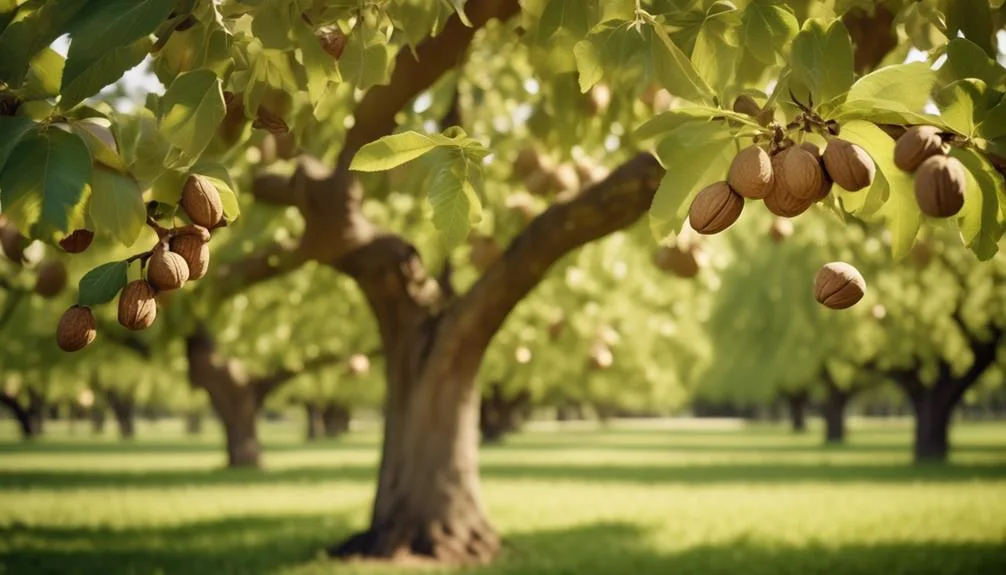Planting walnut trees alongside other nut trees may seem like a competition for resources, but the reality is more complex. The relationship between walnut trees and other nut trees is a hot topic among horticulturists and farmers. There are many factors to consider, such as compatibility, growing conditions, challenges, and benefits.
Understanding these aspects will shed light on the feasibility of growing walnut trees next to other nut trees. So, what's the verdict?
Key Takeaways
- Intercropping walnut trees with other nut trees provides numerous benefits, including maximizing land use efficiency, reducing soil erosion, enhancing biodiversity, and increasing pollination and diverse harvests.
- Nut trees thrive in well-draining soil with a pH level between 6.0 and 7.0, and proper spacing between walnut and other nut trees is crucial for adequate sunlight and airflow, preventing root competition.
- Understanding nut tree pollination is essential, as some nut trees are self-pollinating while others require cross-pollination for optimal fruit production.
- Potential challenges of planting walnut trees near other nut trees include potential competition for resources, root interaction leading to stunted growth and decreased productivity, and differences in growth patterns exacerbating challenges. Careful consideration and management are necessary for successful coexistence.
Compatibility of Walnut Trees With Other Nut Trees
To successfully grow walnut trees alongside other nut trees, it's important to consider their compatibility and potential impact on each other's growth. Intercropping benefits both walnut trees and other nut trees by maximizing land use efficiency, reducing soil erosion, and enhancing biodiversity.
When considering the root competition dynamics, it's crucial to select nut trees with compatible root systems to minimize competition for water and nutrients. For example, planting walnut trees alongside hazelnut trees can be advantageous as their root systems occupy different soil layers, reducing direct competition.
Understanding the root competition dynamics between walnut trees and other nut trees is essential for successful intercropping. By carefully selecting compatible nut trees and considering their root competition dynamics, you can create a mutually beneficial environment for growing walnut trees alongside other nut trees.
Optimal Growing Conditions for Walnut and Other Nut Trees
Consider the ideal growing conditions for walnut and other nut trees to ensure their optimal development and productivity. When planting walnut and other nut trees, it's crucial to pay attention to soil requirements and tree spacing. Nut trees thrive in well-draining soil with a pH level between 6.0 and 7.0. Proper spacing between walnut and other nut trees not only allows for adequate sunlight and airflow but also prevents root competition, ensuring healthy growth. Additionally, understanding nut tree pollination is essential for maximizing yield. While some nut trees are self-pollinating, others require cross-pollination for optimal fruit production. To better grasp the significance of these factors, refer to the table below.
| Factors | Considerations |
|---|---|
| Soil requirements | Well-draining soil, pH 6.0-7.0 |
| Tree spacing | Adequate spacing, preventing competition |
| Nut tree pollination | Self-pollinating or cross-pollinating |
Potential Challenges of Planting Walnut Trees Near Other Nut Trees
Planting walnut trees near other nut trees may pose unique challenges due to potential competition for resources and differences in growth patterns.
The potential competition for resources, such as water, nutrients, and sunlight, can hinder the healthy development of both types of trees. Additionally, the root interaction between walnut trees and other nut trees can lead to competition for space and nutrients in the soil.
This can result in stunted growth and decreased productivity for both types of trees. Moreover, differences in growth patterns, such as varying root depths or canopy sizes, can further exacerbate the challenges of planting walnut trees near other nut trees.
Careful consideration and management of these potential challenges are essential to ensure the successful coexistence and growth of walnut trees alongside other nut trees.
Benefits of Growing Walnut Trees Next to Other Nut Trees
When interplanting walnut trees with other nut trees, you can benefit from increased pollination and diverse harvests. Inter cropping benefits both walnut trees and their nut tree companions.
By growing walnut trees alongside other nut trees, you create a mutually beneficial environment where the trees can cross-pollinate, leading to improved fruit set and higher yields. Additionally, different nut trees have varying nutrient requirements, and by growing them together, they can effectively utilize soil nutrients, reducing the risk of depletion.
This companionship also helps in natural pest control as certain trees can repel pests that may affect others, reducing the need for chemical interventions.
Conclusion: Can Walnut Trees Successfully Coexist With Other Nut Trees?
While interplanting walnut trees with other nut trees can bring various benefits, their successful coexistence depends on careful planning and management. Nut tree interactions and root competition play a crucial role in determining the viability of growing walnut trees next to other nut trees. Companion planting of compatible nut trees can lead to mutual benefits, such as improved pollination, pest control, and efficient land use. However, it is essential to consider the specific requirements of each nut tree species, including their growth habits, water and nutrient needs, and susceptibility to diseases. By carefully selecting companion nut tree species and managing factors like spacing and soil conditions, you can foster a harmonious environment where walnut trees and other nut trees can thrive together. The following table provides a summary of factors to consider for successful coexistence:
| Factors to Consider |
|---|
| Nut Tree Interactions |
| Root Competition |
| Companion Planting |
| Mutual Benefits |
| Effective Management |
Conclusion
Incorporating walnut trees alongside other nut trees isn't only possible, but can lead to a thriving and diverse orchard. By understanding compatibility, optimal conditions, potential challenges, and benefits, a successful coexistence can be achieved.
So, go ahead and plant those walnut trees next to your other nut trees, and watch your orchard flourish with a variety of fruitful yields.

